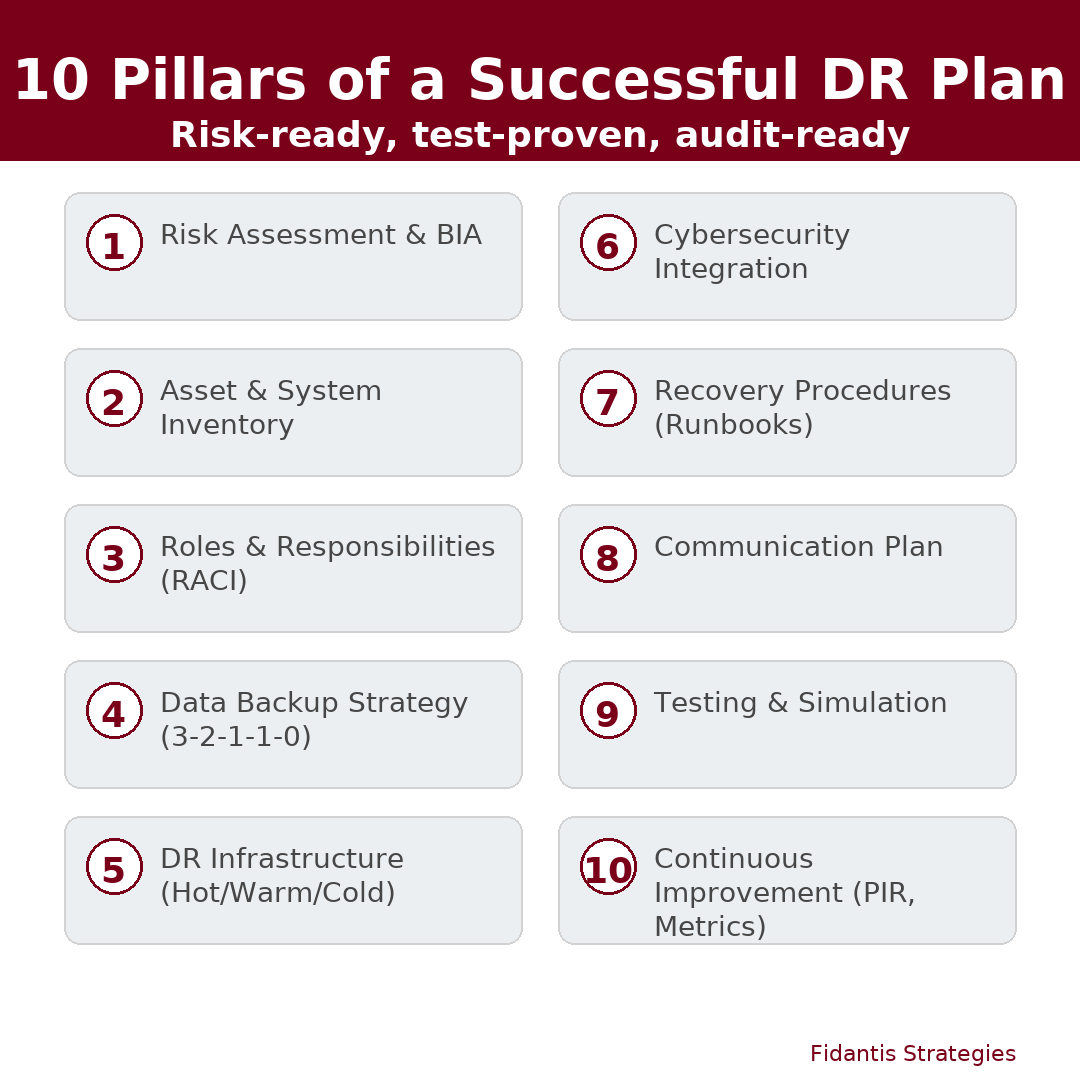Date : 27 Sep 2025
Elements of a Successful Disaster Recovery Plan

1) Risk Assessment & Business Impact Analysis (BIA)
Purpose:
Identify threat scenarios, quantify business impact, and set recovery targets.
Deliverables:
-
- Threat register (cyber, ransomware, hardware, human error, region outage, supplier failure).
- Impact dimensions: revenue, safety, regulatory, legal, brand.
- BIA table with process ↔ application mapping, Recovery Time Objective (RTO), Recovery Point Objective (RPO), Maximum Tolerable Downtime (MTD), and dependencies.
2) Asset & System Inventory
Purpose:
Know exactly what must be recovered and in what order.
Deliverables:
-
- Configuration Management Database (CMDB)-style sheet with: system name, tier (T0–T3), owner, environment, location/region, CPU/RAM/IOPS, Service Level Objectives (SLOs), dependencies.
3) Roles & Responsibilities
Purpose:
Remove ambiguity in a crisis.
Deliverables:
-
- Incident Command System chart (Incident Commander, Operations, Comms/PR, Legal/Privacy, Forensics, App Owners).
- RACI (Responsible, Accountable, Consulted, Informed) for key tasks.
- 24×7 on-call roster & contact list (with escalation paths).
4) Data Backup Strategy
Purpose:
Ensure restorable, verified copies exist across failure domains.
Deliverables:
-
- 3-2-1-1-0 policy: 3 copies, 2 media types, 1 offsite, 1 immutable, 0 verification errors.
- Retention by tier (e.g., T0: 30-day Journal, daily LTR 30 days, monthly 12, yearly 7).
- Encryption (at rest/in transit), and automated restore verification schedule.
5) DR Infrastructure
Purpose:
Define the target topology and prerequisites.
Options:
-
- Hot (near-zero RTO): pre-provisioned compute, warm data, stretched networking.
- Warm (hours): templates/images ready; scale out on failover.
- Cold (days): rebuild from backups.
Plan elements:
-
- Cross-region and cloud-to-cloud patterns (on-prem vSphere → AWS/Azure; region A → region B).
- Network/identity: DNS, DHCP, NTP, IP ranges, VPN/Direct Connect/ExpressRoute, SSO/IdP, PKI, bastions/jump hosts.
- Capacity: CPU/RAM/storage/IOPS, egress allowances, quota reservations, and runbook-driven right-sizing.
6) Cybersecurity Integration
Purpose:
Avoid reinfecting the DR site and maintain security telemetry.
Deliverables:
-
- Clean-room restoration steps (isolated VPC/VNet, no east-west trust, ephemeral admin creds).
- IOC (Indicators of Compromise) scanning before production cutover.
- SIEM (Security Information and Event Management), SOAR (Security Orchestration, Automation and Response), and EDR (Endpoint Detection and Response) continuity plan.
- Secrets/cert rotation workflow (API keys, DB passwords, TLS certs).
7) Recovery Procedures (Runbook Template)
Purpose:
Deterministic steps per application, with evidence capture.
Template:
-
- Pre-checks: health of DR infra, Zerto VPG status, capacity, EDR/Log collectors online.
- Initiate Failover: Zerto live failover or test failover (for exercises). Select consistent checkpoint.
- Post-restore Validation: app smoke tests, data integrity checks, dependency checks (DNS, queues, mail, identity).
- Security Checks: EDR/SIEM review, IOC scan results, secrets/cert rotation complete.
- Failback Plan: resync, schedule cutback window, data delta validation, revert routing/DNS.
- Evidence Capture: export reports, screenshots of tests, ticket numbers, timestamps.
8) Communication Plan
Purpose:
Keep stakeholders aligned without slowing recovery.
Deliverables:
-
- Stakeholder/trigger matrix (who gets what, when a threshold is crossed—e.g., “T0 outage > 15 min”).
- Channels: Slack/Teams bridge, SMS paging, executive brief emails, regulator/customer templates.
- Ready-to-use snippets (internal incident start, customer advisory, regulator notice).
9) Testing & Simulation
Purpose:
Prove it works, not just that it’s documented.
Cadence:
-
- Quarterly targeted exercises (T0 every quarter; T1–T2 semiannual; T3 annual).
- Game/chaos days: inject faults (DNS failure, IAM denial, storage latency).
- Success criteria: observed RTO/RPO vs targets, pass/fail on smoke tests, clean security scans, and documented evidence.
10) Continuous Improvement
Purpose:
Make each test/incident reduce future risk.
Deliverables:
-
- PIR (Post-Incident Review) template with root cause(s), contributing factors, corrective actions, owners, deadlines.
- Quarterly DRP (Disaster Recovery Plan) refresh tied to Change Management (CAB approvals for material changes).
- Metrics tracked over time.
Metrics (define clearly):
-
- Recovery Success Rate: % of applications meeting both RTO and RPO in tests/incidents.
- RTO Delta: Observed RTO − Target RTO (minutes).
- Backup Verification Pass Rate: % of restore tests completed without errors.
- Time to Declare: Incident start → DR declaration (minutes).
- Drill Coverage: % of tiered apps drilled within policy window.
- Mean Time to Recover (MTTR): Start of recovery → service restored (minutes).
- Change Lead Time: Approved change → control in effect (days).

